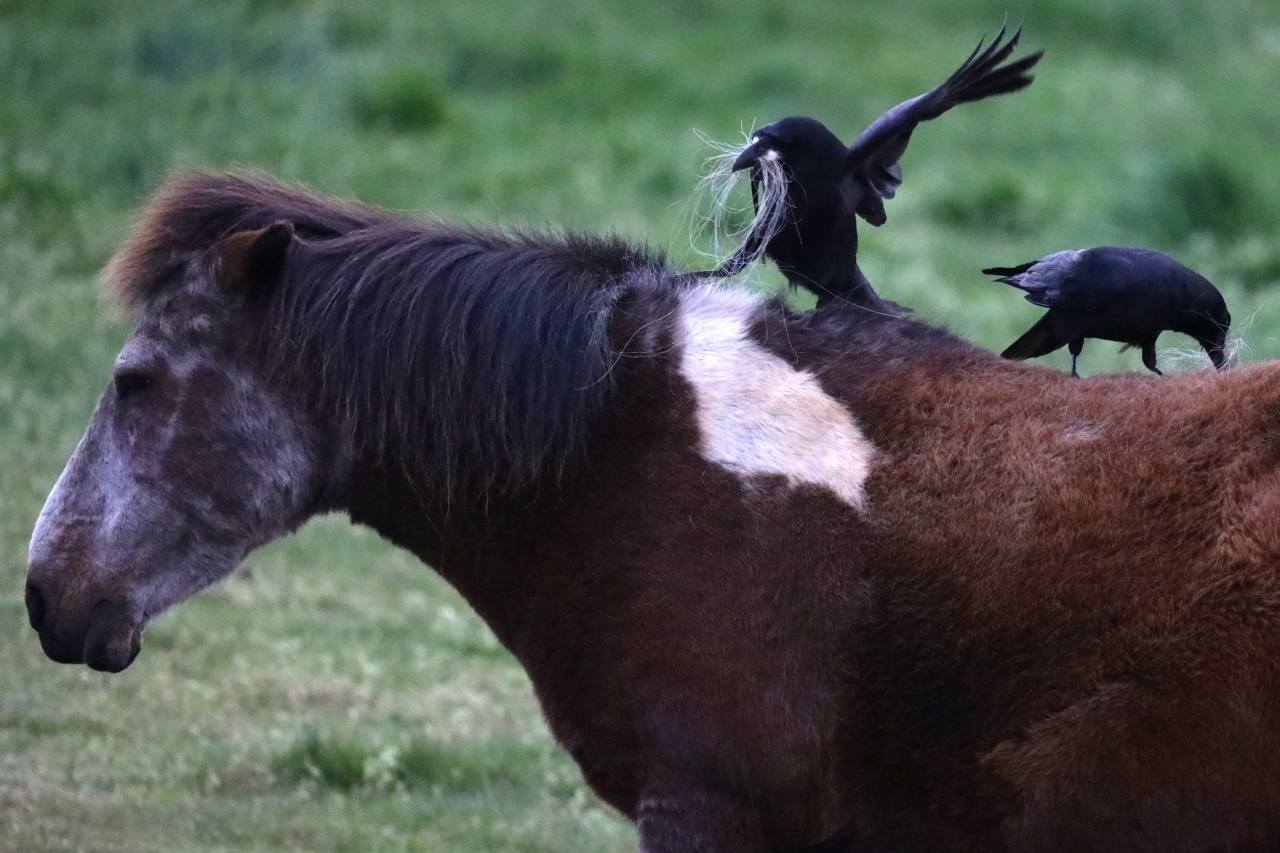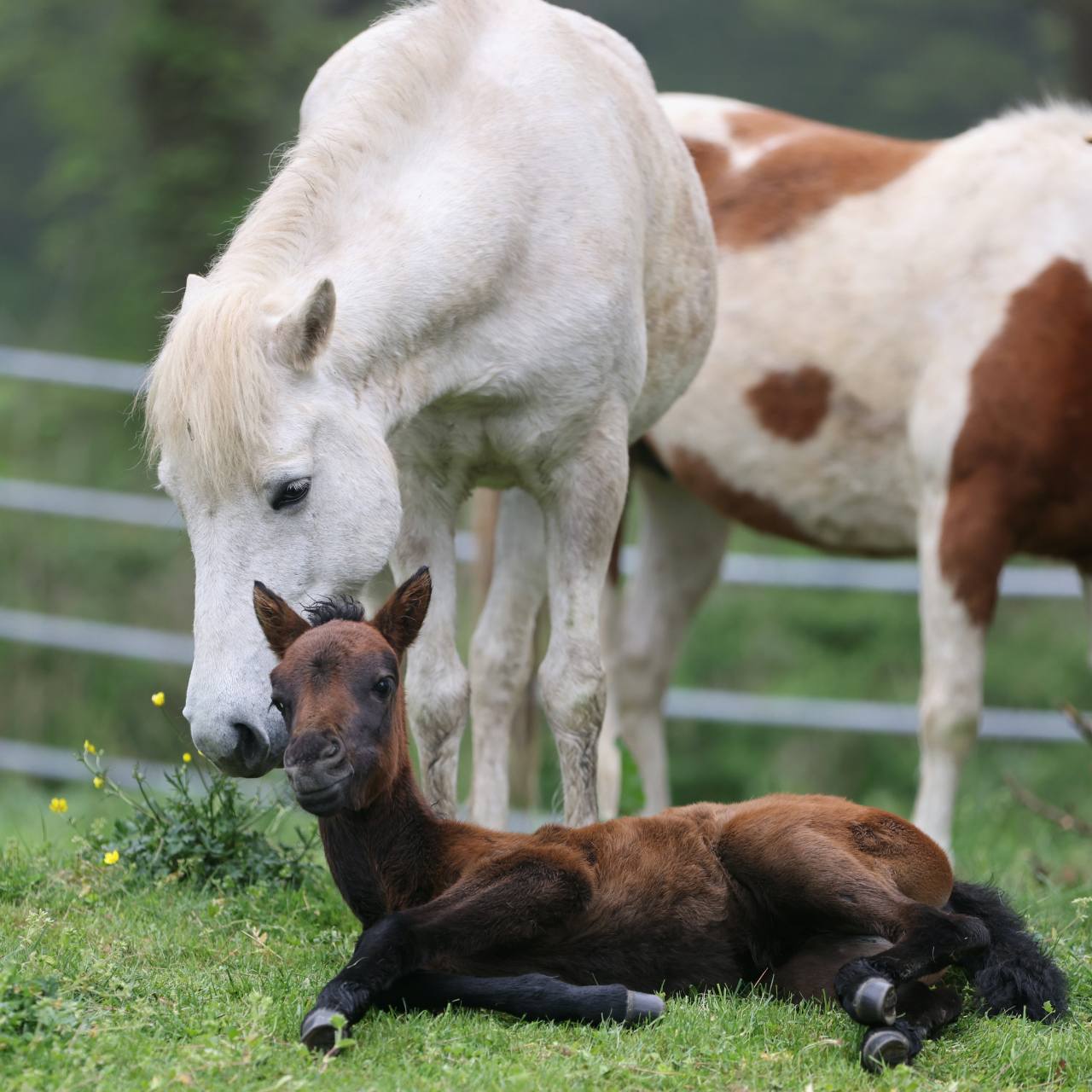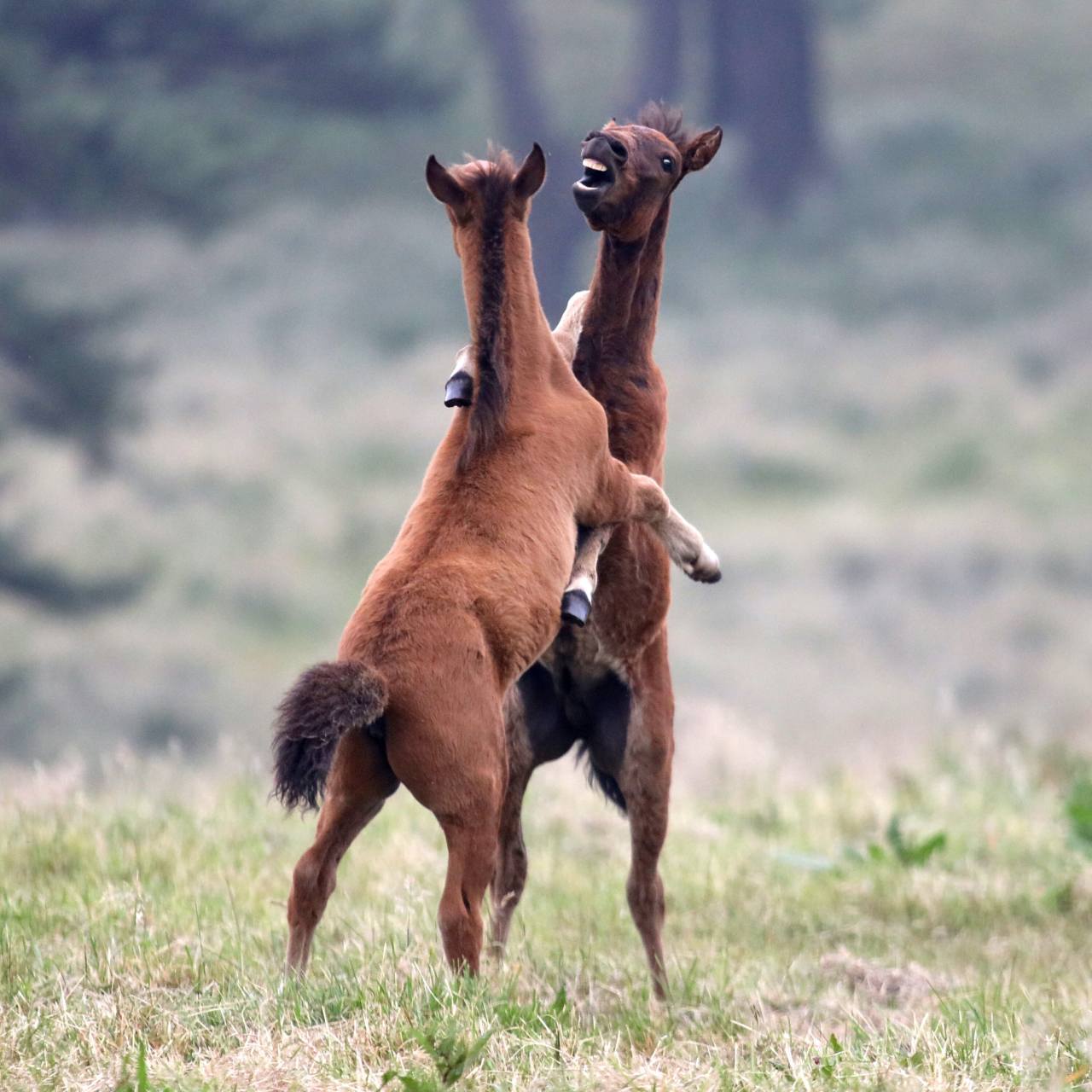[Visual History of Korea] Jeju horses, natives of ancient Tamna Kingdom
By Korea HeraldPublished : April 16, 2022 - 16:01

For most of her history, Jeju Island was better known as the Tamna Kingdom (2345 BC - 1405).
Tamna was one of the nine neighboring enemy countries of Silla (57 BC – AD 918) back in the day. Silla even built the tallest wooden pagoda in Korean history with each level of the nine-story tall pagoda dedicated to fending off the nine enemy states. The Hwangnyongsa wooden pagoda was completed in 645, standing 80 meters tall, before it was burned down by the Mongol invaders in 1238, according to records.
Tamna Island became part of the Goryeo Empire in 1105, and later was incorporated into the Joseon Kingdom in 1404.
Fossilized footprints of Jeju Island’s treasured native horse, Natural Monument No. 347, were found. Jeju native horses have an unusually long forelock, covering across the front of its face like bangs, and horse feathers, the long hair that covers their hoof partially.
Tamna was one of the nine neighboring enemy countries of Silla (57 BC – AD 918) back in the day. Silla even built the tallest wooden pagoda in Korean history with each level of the nine-story tall pagoda dedicated to fending off the nine enemy states. The Hwangnyongsa wooden pagoda was completed in 645, standing 80 meters tall, before it was burned down by the Mongol invaders in 1238, according to records.
Tamna Island became part of the Goryeo Empire in 1105, and later was incorporated into the Joseon Kingdom in 1404.
Fossilized footprints of Jeju Island’s treasured native horse, Natural Monument No. 347, were found. Jeju native horses have an unusually long forelock, covering across the front of its face like bangs, and horse feathers, the long hair that covers their hoof partially.

The Jeju Fossil Site of Human and Animal Footprints, Natural Monument No. 464, along the coastal areas in Seogwipo City, is the fossil site responsible for the very first use of the scientific name “human footprint” and a new discipline of hominid ichnology in geology.
An elementary school teacher discovered the fossil site during one of her frequent visits to the rocky coastal area. Fossilized footprints emerged as waves constantly thrashed against the rocky layers of ancient volcanic deposits, uncovering ancient horse hoof marks in fossils buried under centuries of volcanic ash and rock.
Researchers discovered more than 500 human fossil footprints and a diverse set of birds and animal fossil footprints, including horse and human footprints coexisting in the same time period. Radiometric dating technique showed the fossil footprints at around 7,600-6,800 years ago, since which there were at least three volcanic eruptions on Jeju Island depositing volcanic ashes all over the island.
The ancient horses of Tamna evolved when hybrid vigor occurred among them in the 13th century after large horse farms were established.
Genome analysis showed that the Jeju native horses are a unique and separate breed, evolved on the island, with hybrid vigor occurring as a result of the crossbreeding with 160 horses which were brought in by the Mongols in 1276. The Mongols occupied the island for 100 years after chasing out the Sambyeolcho army in 1273. The Sambyeolcho soldiers had rebelled against Goryeo King Wonjong’s decision to surrender in 1270.
An elementary school teacher discovered the fossil site during one of her frequent visits to the rocky coastal area. Fossilized footprints emerged as waves constantly thrashed against the rocky layers of ancient volcanic deposits, uncovering ancient horse hoof marks in fossils buried under centuries of volcanic ash and rock.
Researchers discovered more than 500 human fossil footprints and a diverse set of birds and animal fossil footprints, including horse and human footprints coexisting in the same time period. Radiometric dating technique showed the fossil footprints at around 7,600-6,800 years ago, since which there were at least three volcanic eruptions on Jeju Island depositing volcanic ashes all over the island.
The ancient horses of Tamna evolved when hybrid vigor occurred among them in the 13th century after large horse farms were established.
Genome analysis showed that the Jeju native horses are a unique and separate breed, evolved on the island, with hybrid vigor occurring as a result of the crossbreeding with 160 horses which were brought in by the Mongols in 1276. The Mongols occupied the island for 100 years after chasing out the Sambyeolcho army in 1273. The Sambyeolcho soldiers had rebelled against Goryeo King Wonjong’s decision to surrender in 1270.

Tough, smart and healthy Jeju horses were sought-after animals for the Mongols who took more than 30,000 horses from Jeju Island during their century of occupation from 1276. During the Yuan period (1271-1368), the Jeju stallions were neutered to tame them for easy riding before being sent out of the island, while mares were left on the island for breeding, according to Dr. Jang Deok-jee, a veterinarian and a Jeju horse researcher.
Tamna horses, abalones and citrus fruits were three mandatory gifts for the Joseon king once the Tamna Kingdom was fully incorporated into the Joseon Kingdom by the 15th century.
Jeju horses, which are still very primitive animals with wild instincts, are able to read human body language and facial expressions, like a companion dog. While they are not the fastest horses at the race track, they are known for their endurance and dominance over larger horses such as the thoroughbred horses which have been imported to the island by the Japanese military and police in the early 1900s.
Horseshoes were introduced to the island with the arrival of thoroughbred horses but they are not used on Jeju horses -- with their tough hooves that have naturally evolved to walk over rocky volcanic islands, they do not need horseshoes, according to Jang, an authority on the history of Jeju horses.
Jeju horses typically have a 340-day gestation period with a quick turnaround of going into heat for about 20 days. ”Some mares deliver their foals on the exact date of each year!“ says Jang.
Running around with poor coordination, the foals attempt to kick their hind legs in midair, thoroughly enjoying their freedom after 340 days spent cramped inside their mother’s belly.
Tamna horses, abalones and citrus fruits were three mandatory gifts for the Joseon king once the Tamna Kingdom was fully incorporated into the Joseon Kingdom by the 15th century.
Jeju horses, which are still very primitive animals with wild instincts, are able to read human body language and facial expressions, like a companion dog. While they are not the fastest horses at the race track, they are known for their endurance and dominance over larger horses such as the thoroughbred horses which have been imported to the island by the Japanese military and police in the early 1900s.
Horseshoes were introduced to the island with the arrival of thoroughbred horses but they are not used on Jeju horses -- with their tough hooves that have naturally evolved to walk over rocky volcanic islands, they do not need horseshoes, according to Jang, an authority on the history of Jeju horses.
Jeju horses typically have a 340-day gestation period with a quick turnaround of going into heat for about 20 days. ”Some mares deliver their foals on the exact date of each year!“ says Jang.
Running around with poor coordination, the foals attempt to kick their hind legs in midair, thoroughly enjoying their freedom after 340 days spent cramped inside their mother’s belly.

The diversified genome of the Jeju horse allows a wide variety of colors within the breed. They appear in 50 different shades from black to white. The natural selection which went on for millennia, plus the human-led injection of 160 Mongolian horses in 1276, resulted in hybrid vigor for the Jeju horse breed, explaining the variations in coat colors.
At 119 centimeters to 122 centimeters in height at their withers, Jeju horses are small compared to thoroughbred horses which are 163 centimeters tall. Yet, despite their size, Jeju stallions are known to be dominating, even over larger thoroughbred stallions. There used to be organized horse fights, where two stallions would bite each other until one ran away. The 2008 animal protection law banned all horse fighting.
The size of the Jeju horses made them highly desirable to the mainlanders, especially the king and his officials.
During the Joseon period, one Jeju horse was of equal value to three human slaves. Due to the high demand, government officials who were dispatched to the island sometimes took horses without consent from barn owners. These prized Jeju horses would, in turn, often be used by government officials to bribe higher officials.
Kim Man-il (1550 - 1632) was a Jeju native who had the most number of horses in the entire Joseon Kingdom. While Kim happily donated many horses to the Joseon king, corrupt officials still commandeered Kim’s horses by force. Kim would often cut off an ear or blind an eye of a horse to keep the breeding stock on the island. His efforts proved successful, as his descendants went on to manage his horse farm for the next 200 years, continuing to supply horses to the king and his military.
After the introduction of farm machines, Jeju horses faced extinction. However, in 1986, the Korean government designated 64 Jeju horses, 55 mares and nine stallions, as a protected species and the Jeju horse population has now returned to a healthy number.
By Hyungwon Kang (hyungwonkang@gmail.com)
---
Korean American photojournalist and columnist Hyungwon Kang is currently documenting Korean history and culture in images and words for future generations. -- Ed.
At 119 centimeters to 122 centimeters in height at their withers, Jeju horses are small compared to thoroughbred horses which are 163 centimeters tall. Yet, despite their size, Jeju stallions are known to be dominating, even over larger thoroughbred stallions. There used to be organized horse fights, where two stallions would bite each other until one ran away. The 2008 animal protection law banned all horse fighting.
The size of the Jeju horses made them highly desirable to the mainlanders, especially the king and his officials.
During the Joseon period, one Jeju horse was of equal value to three human slaves. Due to the high demand, government officials who were dispatched to the island sometimes took horses without consent from barn owners. These prized Jeju horses would, in turn, often be used by government officials to bribe higher officials.
Kim Man-il (1550 - 1632) was a Jeju native who had the most number of horses in the entire Joseon Kingdom. While Kim happily donated many horses to the Joseon king, corrupt officials still commandeered Kim’s horses by force. Kim would often cut off an ear or blind an eye of a horse to keep the breeding stock on the island. His efforts proved successful, as his descendants went on to manage his horse farm for the next 200 years, continuing to supply horses to the king and his military.
After the introduction of farm machines, Jeju horses faced extinction. However, in 1986, the Korean government designated 64 Jeju horses, 55 mares and nine stallions, as a protected species and the Jeju horse population has now returned to a healthy number.
By Hyungwon Kang (hyungwonkang@gmail.com)
---
Korean American photojournalist and columnist Hyungwon Kang is currently documenting Korean history and culture in images and words for future generations. -- Ed.
-
Articles by Korea Herald








![[KH Explains] How should Korea adjust its trade defenses against Chinese EVs?](http://res.heraldm.com/phpwas/restmb_idxmake.php?idx=644&simg=/content/image/2024/04/15/20240415050562_0.jpg&u=20240415144419)











![[Today’s K-pop] Stray Kids to return soon: report](http://res.heraldm.com/phpwas/restmb_idxmake.php?idx=642&simg=/content/image/2024/04/16/20240416050713_0.jpg&u=)